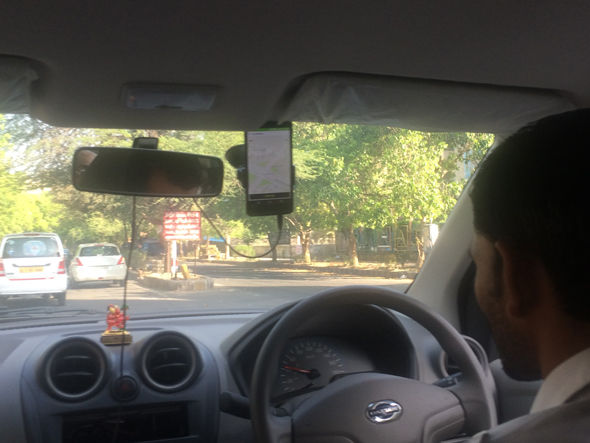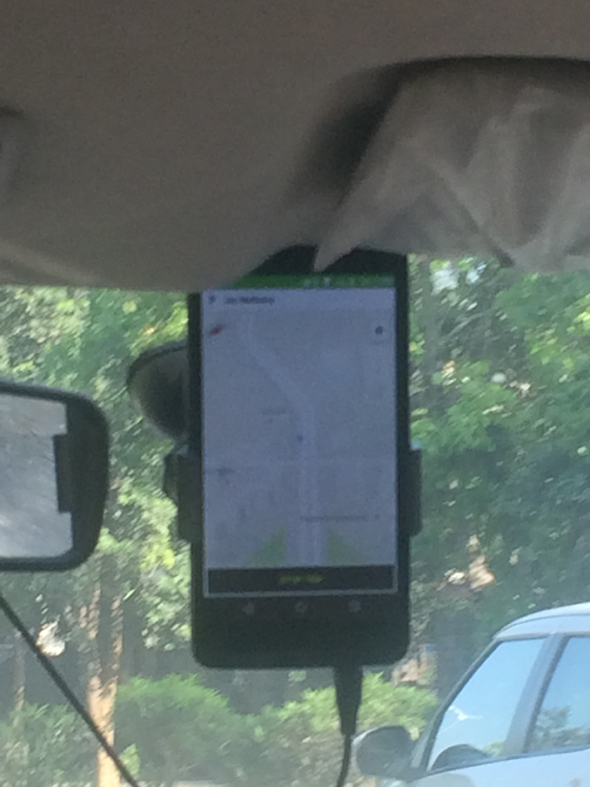Unexpectedly, Uber and Other Ride Shares Spread the Wealth in India
By Jawahar Malhotra
NEW DELHI: I took my umpteenth ride in an Uber cab the other night and was still marvelling at the way the system works in India when I got another important lesson when the system broke down. With headlights coming straight at him and the bumpy road suddenly becoming two lanes in each direction, the driver made a sharp turn to the right and just then, the GPS device that was secured in a dashboard holder fell to the floor, the power cord jerked out and the guidance system went dead. The driver pulled over to the side of the road a few yards afterwards and turned on his blinkers to check.
My mother and I waited a few minutes for the driver to get started again but the GPS device wouldn’t boot up inspite of the driver pushing the button on the side and repeatedly re-inserting the power jack. Then he did something I didn’t quite expect. This uneducated young man barely familiar with his first brush with high-technology quickly reached into his glove compartment and pulled out an Ethernet cable while he called customer service to explain the problem. I marveled while he tried to grapple with the stubborn device and when it seemed hopeless, I opened the app on my cell phone of a competing service, the Bangalore-based Ola, to guide in a cab to the stretch of dark road with a steady stream of traffic to take us onwards. The Ola driver shook his head and said it would cost the Uber driver Rs. 7,000 to have the device replaced.
Central to the way the ride share programs work in New Delhi and a few other cities in India – and there are several others like Ola, Jugnoo and Share My Ride – is the GPS device which is given free to the drivers who sign up (but pay Rs. 100 per month afterwards), who are tickled pink that they have this piece of high-powered technology. They carry their own mobile phones to make and receive calls, but the device is their GPS God to making money. The device knows where you are and can find your pickup point on a map, and equally important is that you can see the location of the driver too; his name, license plate, cell number and can call them to guide them to where you are.
You even have a choice of rides on the two most popular ones: on Uber it’s between sharing in a pool, solo or the premium service and on Ola you can select an auto rickshaw, micro, mini, sedan or Prime vehicle. The main difference is the price structure and the driver always swipes his phone screen to start and to receive the fare from the device at the end of the journey. Interestingly, in Pune, where Ola has recently entered the market, the auto rickshaw driver only responded to the call but used his own meter. He was tickled that he could pocket all the cash and didn’t have any reporting to do, but that is probably Ola’s strategy for penetrating the market and building a network of operators.
One major benefit of the ride shares is that mobile technology has not only penetrated the market place but also the mindset of otherwise semi-literate drivers. They understand how GPS works, follow directions in English (with an American accent) and have their have own e-bank accounts to transfer their fares daily, after deducting commissions. And suddenly, thanks to GPS, Delhi has risen from the depths of foggy knowledge of whereabouts to a city with street names.
Ride share services have taken out the sting from one of the final hurdles for traveling in Delhi as you don’t have to waste time chasing after a taxi or rickshaw anymore and negotiate a fare. Empowered with the powerful GPS device, the drivers are always busy and don’t have to wait at taxi stands or loiter the roads to make money, which they are equally delighted, that they can make in bundles.
To penetrate the market, ride share leaders Uber and Ola are making joining their services very enticing by offering drivers other incentives too. Both charge a hefty commission on each fare – Uber takes 25% and Ola 20% – and each vary in the way the “driver’s duty” period is estimated. Each offers drivers incentives for being available: up to Rs. 800 ($12) for four “duties” a day, even if it’s up to the next traffic light and a kilometer rate of upto Rs. 20 ($0.30) while the fare is computed at a lower rate.
Some drivers who own their cars claim they can make upto Rs. 150,000 ($2,307) a month and take home between Rs. 50,000 to 80,000 ($770 to &1,230) after expenses. That’s a powerful attraction in Delhi where drivers, who are really hard to find, get only Rs. 15,000 to 18,000 ($230 to $277) a month when employed by others and many Ola drivers are bidding their time to buy their own vehicles, which are available for as low as Rs. 600,000 or about $9,000. Ride shares, rickshaws and the all-encompassing Metro got a boost when the local city government of Arvind Kejriwal announced another two-week experiment starting April 15, of allowing cars on the roads only on alternate days based on the car’s odd or even numbered license plate. In anticipation, Ola will start offering a much cheaper electric rickshaw shuttle. At present there are 90,000 auto rickshaws in Delhi: that number is expected to boost to 100,000 by the end of the year.
The lure has been enough to entice young men from educated and even well-off families to enlist in the ride sharing programs, though not without some embarrassed looks for breaking into what is considered menial work of the lower class. One young Sikh drove around one afternoon, his head covered by a cap and the other night, an obvious college-aged, sullen young man with a disdainful attitude drove us back home. Its good money in a country with chronic under employment and helps pay for their new cars, of which there is no shortage of in India.
There is another sinister and less acknowledged side to this unexpected spread of wealth from what are termed “e-rickshaws”, an oversized golf-cart type of battery driven rickshaw that picks up riders who share the same route. On the day of the religious holiday Holi celebrating the advent of Spring, on Thursday, March 24, a 42year-old dentist was killed after being attacked by a mob of young men who beat him up with iron rods and cricket bats. The incident started with a minor altercation as the dentist exchanged a few hot words while retrieving a ball that had flown into the street from his house. The young man who was the ring leader, Nasir, was offended by the slight and brought in others from his slum to extract revenge. Apparently, his new found wealth from driving ride shares had giving him the clout to demand a following and obedience. He and others (including his mother who works as a maid and who egged him on) were later apprehended the next day, thanks to another high-tech gadget that you would expect not to find in Delhi: a surveillance camera in the street.


